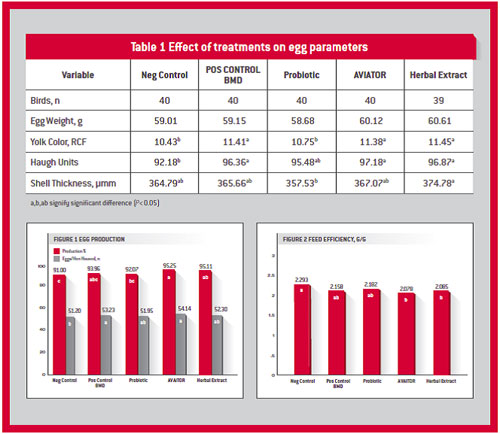RFCs Boost Egg Production Efficiency
RFCs are the components harvested from yeast cells (S. cerevisiae) using specific enzymes during the manufacturing process. This enzymatic hydrolysis yields MOS (Mannan Oligosaccharides), (1,3-1,6) beta glucans and D-Mannose.
These compounds are naturally present in all yeast cells, but are not readily bioavailable. The method of processing used to refine the yeast cells influences the size and structure of these liberated components which, in turn, affect bioavailability and functionality. Research2,3,4 shows that each RFC has a specific mode of action and outcome when fed to livestock.
CELMANAX™, sold as AVIATOR™ in certain international markets, is a unique feed additive containing RFCs and is designed to improve overall health, growth and feed conversion in poultry. Multiple studies in broilers show these benefits to be consistent.
But what impact does it have for layers?
Trial Design
Researchers recently set out to determine if AVIATOR can offer the same efficiency benefits for layers. And they explored how well it compares to some other common feed additives.
The study was conducted in Guatemala and featured 200 Lohman White Classic layers at 28 weeks of age. The birds were allotted into five treatments in a completely randomized block design. The 10-week study included four birds per cage, with eight replications per treatment.
The birds were give a two-week adaptation period that was followed by eight weeks of data collection. A basal layer diet was formulated to meet the strain of egg-type chicken used. Water via two nipple drinkers per cage and mash feed prepared at a commercial feed mill was provided. In addition, 14.5 hours of total light (3.5 hours of artificial light) was provided during the study.
Research Results
Data showed that AVIATOR results were excellent compared to some of the other competitors. AVIATOR was very good at improving both egg production efficiency as well as improving some of the egg parameters, supporting its application in the layer industry very well.
For example:
• All treatments improved egg production compared to control, but AVIATOR gave the largest numerical improvement in % production and number of eggs/hen housed compared to other feed additives tested (Figure 1).
• Feed efficiency was improved in hens supplemented with AVIATOR and Xtract compared to all other treatments (P<0.05) (Figure 2).
In addition, results also showed:
• Egg weight was not affected by treatments (Table 1).
• Egg yolk color was significantly higher in hens supplemented with BMD,® AVIATOR, and Xtract compared to control and probiotic (Table 1).
• Egg shell thickness was highest in hens receiving Xtract and lowest in those receiving the probiotic, with all other treatments being intermediate (Table 1).

Therefore, we are able to conclude that AVIATOR fed to layers resulted in the largest improvement in layer performance while improving some egg parameters compared to other feed additives tested.
Future research will focus on measuring the food safety benefits of including AVIATOR in poultry diets. To learn more, visit AHanimalnutrition.com or watch this video.
1 Castaneda G, Jalukar S, Mann H, The effect of AVIATOR supplementation compared to other feed additives on layer performance. Presented as abstract P327 at 2016 IPSF, Atlanta, Ga. AHAN Research. Available on request.
2 Hashim A, Mulcahy G, Bourke B, Clyne M. Interaction of Cryptosporidium hominis and Cryptosporidium parvum with Primary Human and Bovine Intestinal Cells. Infection and Immunology 2006;74(1):99.
3 Nocek J, Holt MG, Oppy J. Effects of supplementation with yeast culture and enzymatically hydrolyzed yeast on performance of early lactation dairy cattle. J Dairy Sci 2011;94:4046-4056.
4 Baines D, Erb S, Turkington K, Kuldau G, Juba J, Masson L, Mazza A, Roberts R. Mouldy feed, mycotoxins and Shiga toxin - producing Escherichia coli colonization associated with Jejunal Hemorrhage Syndrome in beef cattle. BMC Veterinary Research 2011;7:24.




